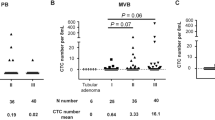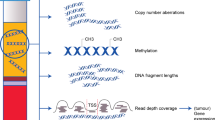Abstract
Quantification of circulating cancer cells in whole blood samples by real time quantitative RT–PCR might be of clinical value for monitoring therapeutic effectiveness. In colon cancer patients, carcinoembrynic antigen (CEA) and cytokeratin 20 (CK20) have been frequently used for RT–PCR based tumor cell detection, but the specificity in particular for CEA has been questioned. In this study, we compared real-time RT–PCR for CEA and CK20 and analysed patients with metastatic disease (n=32) and healthy volunteers (n=17). CK20 mean values were elevated in cancer patients (P<0.001) and defined a subgroup (38%) who showed CK20 levels at least 100-fold above the highest value of the healthy control group. In contrast, only two cancer patients (6%) showed elevated CEA levels. Samples of the healthy control group showed exclusively a CEA-PCR product of 79°C melting temperature. Thirty per cent of the colon cancer patients showed an additional product of 82°C melting temperature. The 82°C product was identical with the amplification product of CEA-cDNA and cDNA from different colon cancer cell lines. Colon cancer cells were spiked into normal blood in 10-fold dilutions that resulted in a dose dependent shift of the melt curve from 79°C to the 82°C. Sequencing of the PCR products showed that white blood cells express a splice variant of CEA, which hinders detection of tumor cell cDNA in whole blood samples. Our findings have implications for the use of CEA as a diagnostic molecule (e.g. by RT–PCR). The discovery of a physiologically expressed CEA splice variant might lead to a better understanding of the biological function of CEA and its family members.
This is a preview of subscription content, access via your institution
Access options
Subscribe to this journal
Receive 50 print issues and online access
$259.00 per year
only $5.18 per issue
Buy this article
- Purchase on Springer Link
- Instant access to full article PDF
Prices may be subject to local taxes which are calculated during checkout




Similar content being viewed by others
References
Benchimol S, Fuks A, Jothy S, Beauchemin N, Shirota K, Stanners CP . 1989 Cell 5: 327–334
Burchill SA, Bradbury MF, Pittman K, Southgate J, Smith B, Selby P . 1995 Br. J. Cancer 71: 278–281
Castells A, Boix L, Bessa X, Gargallo L, Pique JM . 1998 Br. J. Cancer 78: 1368–1372
Engell H . 1955 Acta Chir. Scand. 210: (Suppl) S10–S70
Gangopadhyay A, Lazure DA, Thomas P . 1998 Clin. Exp. Metastasis 16: 703–712
Gerhard M, Juhl H, Kalthoff H, Schreiber HW, Wagener C, Neumaier M . 1994 J. Clin. Oncol. 12: 725–729
Goeminne JC, Guillaume T, Symann M . 2000 Ann. Oncol. 11: 785–792
Guadagni F, Kantor J, Aloe S, Carone MD, Spila A, D'Alessnadro R, Abbolito MR, Cosimelli M, Graziano F, Carboni F, Carlini S, Perri P, Sciarretta F, Greiner JW, Kashmiri SV, Steinberg SM, Roselli M, Schlom J . 2001 Cancer Res. 61: 2523–2532
Grem J et al . 1997 Curr. Opin. Oncol. 9: 380–387
Hammarström S . 1999 Semin. Cancer Biol. 9: 67–81
Juhl H, Stritzel M, Wroblewski A, Henne-Bruns D, Kremer B, Schmiegel W, Neumaier M, Wagener C, Schreiber HW, Kalthoff H . 1994 Int. J. Cancer 57: 330–335
Jung R, Kruger W, Holsch S, Holweg M, Kroger N, Gutensohn K, Wagener C, Neumaier M, Zander AR . 1998 Br. J. Cancer 78: 1194–1198
Ko Y, Klinz M, Totzke G, Gouni-Berthold I, Sachinidis A, Vetter H . 1998 Clin. Cancer Res. 4: 141–146
Liefers GJ, Cleton-Jansen AM, van de Velde CJ, Hermans J, van Krieken JH, Cornelisse CJ, Tollenaar RA . 1998 N. Engl. J. Med. 33: 223–228
Lindemann F, Schlimok G, Dirschedl P, Witte J, Riethmuller G . 1992 Lancet 340: 685–689
Mori M, Mimori K, Ueo H, Karimine N, Barnard GF, Sugimachi K, Akiyoshi T . 1996 Int. J. Cancer 68: 739–743
Redding WH, Coombes RC, Monaghan P, Clink HM, Imrie SF, Dearnaley DP, Ormerod MG, Sloane JP, Gazet JC, Powles TJ . 1983 Lancet 2: 1271–1274
Schlimok G, Funke I, Holzmann B, Gottlinger G, Schmidt G, Hauser H, Swierkot S, Warnecke HH, Schneider B, Koprowski H, Riethmüller G . 1987 Proc. Natl. Acad. Sci. USA 84: 8672–8676
Schott A, Vogel I, Krueger U, Kalthoff H, Schreiber HW, Schmiegel W, Henne-Bruns D, Kremer B, Juhl H . 1998 Ann. Surg. 227: 372–379
Schrewe H, Thompson J, Bona M, Hefta LJ, Maruya A, Hassauer M, Shively JE, von Kleist S, Zimmermann W . 1990 Mol. Cell Biol. 10: 2738–2748
Soeth E, Roder C, Juhl H, Kruger U, Kremer B, Kalthoff H . 1996 Int. J. Cancer 69: 278–282
Soeth E, Vogel I, Roder C, Juhl H, Marxsen J, Kruger U, Henne-Bruns D, Kremer B, Kalthoff H . 1997 Cancer Res. 57: 3106–3110
Soeth E, Wirth T, List HJ, Kumbhani S, Petersen A, Neumaier M, Czubayko F, Juhl H . 2001 Clin. Cancer. Res. 7: 2022–2030
Thompson J et al . 1994 J. Biol. Chem. 269: 32924–32931
Vogel I, Francksen H, Soeth E, Henne-Bruns D, Kremer B, Juhl H . 2001 Am. J. Surg. 181: 188–193
Wirth T, Soeth E, Czubayko F, Juhl H . 2002 Clin. Exp. Metastasis. 19: 155–160
Acknowledgements
Dan P Hartman, Department of Pathology, Georgetown University Medical Center and Jeff M Smith, Bio-Rad Laboratories, for numerous helpful suggestions This work was supported by a grant of the National Institute of Health/National Cancer Institute (#R01-CA088972), and Lombardi Cancer Research Center Core Facility, U.S. Public Health Service Grant 2P30-CA-51008
Author information
Authors and Affiliations
Corresponding author
Rights and permissions
About this article
Cite this article
Hampton, R., Walker, M., Marshall, J. et al. Differential expression of carcinoembryonic antigen (CEA) splice variants in whole blood of colon cancer patients and healthy volunteers: implication for the detection of circulating colon cancer cells. Oncogene 21, 7817–7823 (2002). https://doi.org/10.1038/sj.onc.1205906
Received:
Revised:
Accepted:
Published:
Issue Date:
DOI: https://doi.org/10.1038/sj.onc.1205906
Keywords
This article is cited by
-
Prognostic significance of CEACAM5mRNA-positive circulating tumor cells in patients with metastatic colorectal cancer
Cancer Chemotherapy and Pharmacology (2018)
-
Diversity of assessing circulating tumor cells (CTCs) emphasizes need for standardization: a CTC Guide to design and report trials
Cancer and Metastasis Reviews (2015)
-
Nanotechnology for the detection and kill of circulating tumor cells
Nanoscale Research Letters (2014)
-
Novel protein isoforms of carcinoembryonic antigen are secreted from pancreatic, gastric and colorectal cancer cells
BMC Research Notes (2013)
-
Use of DNA melting simulation software for in silico diagnostic assay design: targeting regions with complex melting curves and confirmation by real-time PCR using intercalating dyes
BMC Bioinformatics (2007)



